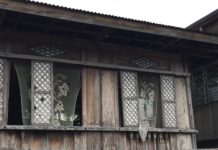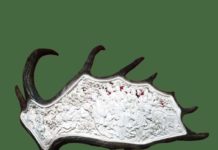Archeological findings of the finely carved ivory comb, unearthed in Mohenjodaro (2300-1750 BCE) and excavations from other later sites, have revealed the enduring use of ivory, horn and bone to carve objects. The purposes of carving extended from religious and ritual requirements and personal needs to its use in the decorative arts. Thiruvanthanapuram and Thrissur in Kerala were ancient reputed centers for ivory carving, where objects were created that depicted a wide range of subjects, including Hindu gods, goddesses and sacred beasts; Christian symbols and icons; and shrines serving both decorative and religious and ritual needs. With the ban on ivory in 1972, the craftspersons shifted to alternative raw materials. The carvers of sacred objects moved to wood, while decorative objects are now carved in horn.
Large objects are usually carved with buffalo horn, while bullock horns are used for smaller objects and the bullhorn is considered suitable for carving the intricate add-on parts. The tools used range from a fiddle drill, to needles, hammers, pliers, etching tools, files and chisels. The carving process commences once the outer layer of the horn is removed. Once the basic form is chiseled out, the horn is softened by heating making it pliable for shaping and etching in details and patterns. The rough surface is smoothened by rubbing with the milky kapadlaava (jackfruit leaf). The even ebony color is achieved by applying the paste of burnt palm leaf ash on to the porous surface of the horn. The object is finished by highlighting the etched areas in a mix of white chalk and glue.
The designs have remained unchanged over the years with decorative objects from models of birds and animals, toys and miniature snake boats to paperweights, vases, buttons, trays, and ashtrays. This static nature of design has led to a declining market with a dwindling number of traditional artisans.





I have a carved horn bird similar to those in the photo above. A label on the bottom of the base indicates that it was hand carved in India, Ref. No. 16, Size 11. A piece of the beak has broken off and I have the piece. Do you have any recommendations for gluing it back on?
Thanks, Rich